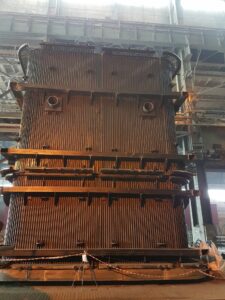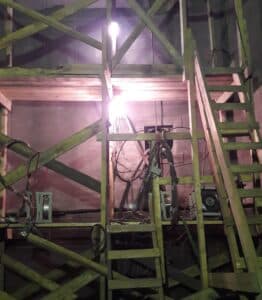Integrated Group Services’ (IGS) high velocity thermal spray has improved a copper flash smelting furnace’s performance and lifetime.
Introduction

A copper smelter went into production in the 1940s. Since its inception, the plant has been modernised several times.
The plant operates two copper flash smelting furnaces with a unique equipment configuration. The boilers are located directly above the furnace’s uptakes, making the risk of water entering the furnace very high.
The plant has the capacity to produce 150 000 tonnes of copper matte per year. They had ambitious plans for production development.
High-temperature corrosion
Flue gas temperature inside the boiler reaches 1350°C/2462°F causing rapid metal wastage and slagging. Slagging could not be removed manually due to access issues.
IGS’ high velocity thermal spray (HVTS) application timelines

2018: pilot project to stop metal loss in the most dangerous area. 20m2 area protected from corrosion with HVTS. Critical path: two days.
2019: 123m2 area protected from corrosion with HVTS. Critical path: six days.
2020: visual and UT (ultrasonic testing) inspection, no metal wastage identified, slagging significantly reduced.
2021: lower area is protected with HVTS. Critical path: six days.

Boiler waterwall protection
IGS’ HVTS solutions upgrade existing metallurgy to higher alloys that provide a barrier to mitigate corrosion and/or erosion in mission-critical equipment around the world.
IGS has performed over 4000 site projects and installed millions of square feet of reliable metal cladding surface protection.

IGS HVTS solution benefits
Efficiency: deslagging was the first major benefit achieved because of the HVTS application reported by the plant. The boiler slows down every month.
During these periods, plant management teams perform a visual inspection of the equipment. No slagging has been detected on the boiler wall. The efficiency improvement increased production in 2020 to 112 per cent of design capacity.
Lifetime: boiler replacement is costly and time-consuming. IGS HVTS application prevented the degradation of the heat recovery steam generator, which previously lasted only 24 months. The trial application provided a clear side-by-side comparison.
Reliability: prior to the IGS HVTS application, the plant used to carry out emergency localised shell repair.
The next step
The plant has now included IGS HVTS technology in its best practices list. It plans to install IGS surface technologies onto the refractory surfaces and the convection section coils to eliminate slagging and increase the production rate.
“Non-ferrous metallurgy presents a very severe environment, which truly puts our HVTS technology to the test,” IGS manager Sergei Merchev, who oversaw the project, said.
“Our experience, expertise and collaborative approach made this application a success and produced undisputed value for the customer.”
For more information, visit the IGS website.




